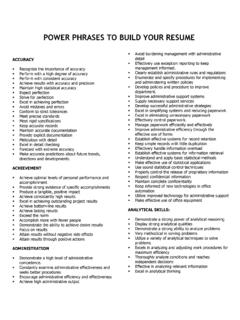Transcription of A whole school framework for emotional well being and ...
1 A whole school framework for emotional well being and mental healthA self-assessment and improvement tool for school leadersPartnership for Well- being and Mental Health in SchoolsSue Stirling and Dr Hilary Emery2|Context Schools want to provide effective and enjoyable teaching and learning environments, where children and young people flourish. These depend on good staff and student relationships across the whole school , including with governors, and externally with families, the wider community and other services. Professor Katherine Weare reviewed the research into what works in schools to improve children and young people s well- being and mental health What works in promoting social and emotional well- being and responding to mental health problems in schools? Advice for Schools and framework Document i.
2 She found that a whole school commitment and ethos, rather than piecemeal approaches, are key to making a difference. Schools have a wide variety of practice in their daily teaching and pastoral care that support social and emotional wellbeing yet they face increasing wellbeing and mental health challenges among students and staff. If existing practices are systematically co-ordinated they can improve wellbeing and help to prevent mental health issues. Where needs and gaps in practice are then identified they can be addressed by careful selection of intervention programmes, staff development and working with external health and social care partners. Amidst budget constraints, curriculum and examining changes and the relentless focus on standards and performance a focus on wellbeing may be seen as a distraction.
3 However, done well it can enhance attainment, reduce exclusions, re-engage students who have experienced problems, build good relationships, attract and retain staff and raise standards across the , iiiWhy look at social and emotional well- being and mental health now? Policy The Departments of Education (DfE) and Health (DH) are committed to improving the mental health and wellbeing of children and young people:In order to help their pupils succeed, schools have a role to play in supporting them to be resilient and mentally healthy ivThe DH policy Future in Mind v, expects schools to be active partners in local areas through the Local Transformation Plans include consideration of wellbeing in the Personal development, behaviour and welfare section of the schools inspection Supporting children and young people s social and emotional health and well- being contributes to positive academic progress.
4 It helps them to manage their lives including their physical health, tackle any mental health problems early and develop high level social and emotional , as well as academic, skills vii thereby enhancing future employability. Supporting the wellbeing of teachers and staff contributes to staff retention, whole school ethos and classroom effectiveness is happening now?The social and emotional wellbeing and mental health of children, young people and staff are powerful influences in every school , every day. Working with schools we identified three barriers to change:What s the problem? What difference can schools make?Schools report increasing numbers and complexity of wellbeing and mental health issues among children, young people and staff. Causes include the pressures of examinations and assessments, social media and Ofsted.
5 Public Health England s (PHE) evidence suggests in an average class of thirty 15-year-olds ix: three could have a mental disorder ten are likely to have witnessed their parents separate one could have experienced the death of a parent seven are likely to have been bullied six may be evidence ii about the impact of supporting wellbeing shows: social and emotional competencies are a more significant determinant of academic attainment than IQ; pupils who are confident about learning and have a growth mindset persist when faced with challenges; pupils who can set goals, manage stress and organise their school work achieve higher grades; pupils who use problem-solving skills to overcome obstacles do better research foundiii: Children with higher levels of emotional , behavioural, social, and school wellbeing, on average, have higher levels of academic achievement and are more engaged in school , both concurrently and in later years.
6 Children with better emotional wellbeing make more progress in primary school and are more engaged in secondary can this resource helpThe tool signposts evidence from research and practice. It offers prompts for debate and activity bringing everyone together and building on existing practice, identifying new programmes and interventions, setting priorities and implementing and evaluating change. This tool aims to help you: Build a common language, understanding the evidence about what works, getting a shared understanding of what is happening in schools now, identifying the gaps and opportunities in current practice and developing a whole school ethos and culture. Involve students and staff in planning, and developing practice, including early identification and intervention using existing practice supported by new initiatives where needs arise.
7 Work with families and other services to promote wellbeing, prevent and reduce mental health problems and intervene early when these arise with effective support and services. Implement a systematic and strategic approach across the school and evaluate progress for individual children, young people and the whole school ; embedding and sustaining effective practices. Drawing on Professor Weare s evidence review of what works the tool is intended to help school leaders to identify and address the rapidly changing and demanding pressures and expectations they face. school leaders need to decide both how to respond systematically to individual mental health problems and build resilience, influence attitudes and behaviours and create a culture that promotes and protects wellbeing across the school and with families and partners.
8 We have compiled a compendium of additional toolsx and resources to support this approach (see ). Mental health has tended to be seen as the domain of experts and as such is outside schools remit; Issues that arise hit schools at different levels and ways meaning connections between them that relate to the mental health and wellbeing of individuals and groups may be hard to spot; Wellbeing and mental health support are not high profile or seen as core business for everyone in schools.|3 Stage one: Deciding to act and identifying what is in place already Identifying what happens and what matters in your school What is expected of us? How do we do well being and mental health now? Teaching and learning Student voice Policies Curriculum subjects and PSHE Assessment and exams Pastoral support Who does what?
9 Who do children and young people go to? Role of SLT, governors, support staff, teachers, pupils Mapping what happens already: who leads what, how is information communicated and who is involved within and beyond schoolIdentifying concerns: whole school , specific groups and individualsCurrent challenges and opportunities identified links and gaps Stage three: Building relationships and developing practices Capacity and relationship building: consolidating what works, stopping what doesn t and implementing proven new strategies to meet needs Planning objectives and timescales to implement the vision and priorities including tackling gaps in provision and expertise: who needs to agree, external and internal? How to overcome resistance? Deciding what to change, when, who leads change process, what outcomes?
10 What roles are needed and who will take them? Building links with external partners, health, CAMHS and social servicesCollecting data about needs, identifying gaps in data and provision. Evaluate additional universal and targeted provision to meet needs of students and staffIdentify development and information sharing opportunities for teaching and support staff; for partners in health; for students and families Action plan in place with objectives to support vision agreed. Activity targeted to deliver objectives and meet needs and aspirationsLink to wider services established with agreement about actions and objectivesScheduled plan with milestones and named personnel taking responsibility for leading processesNew support and interventions identified and links made across leadership, staff training for prevention, identification, early intervention and accessProcedures for working with external partners agreed and implemented Stage four: Implementation and evaluation Tracking and evaluating progress, embedding and sustaining practice Deciding what good looks like for children and young people.








